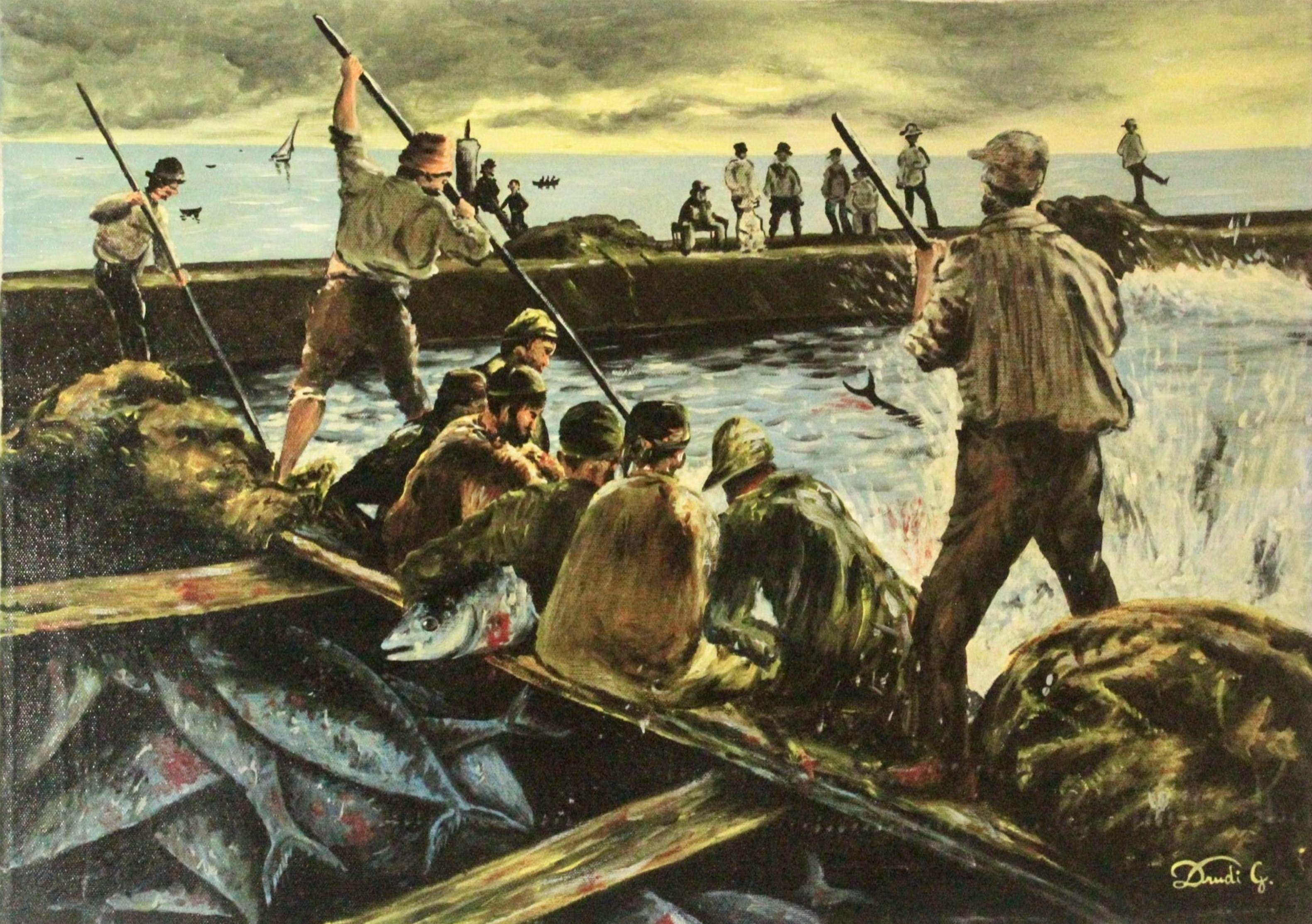THE TUNA FISHING
1977, 50x70cm, Tempera on canvas with glossy spray fixative

Evocative moment of tuna fishing. Sky, sea, and fishermen seem to be one with the tuna.
The work “The Tuna Fishing,” created in 1977 with tempera on canvas and finished with glossy spray fixative, represents with great intensity and realism a traditional fishing scene, immortalizing one of the most raw and authentic moments of maritime life.
Composition and atmosphere:
The painting is full of dynamism and tension, capturing the moment when the fishermen, with their harpoons, deliver the coup de grace to the trapped tuna. The agitated movement of the fishermen contrasts with the immobility of the men on the breakwater, who observe the scene with attention. The vigorous brushstrokes and earthy colors confer a strong expressiveness to the work, while the cloudy sky and the rippled sea seem to almost merge with the energy and fatigue of the fishermen.
Details and painting technique:
The artist uses sharp contrasts of light and shadow to enhance the realism of the scene; the glow of broken waves opposes the darkness of nets and massed fish. Ochre, brown, and dark green tones dominate the palette, evoking the harshness of sea life. The detail of the tuna in the foreground, with their shiny skin marked by blood, adds a strong emotional impact to the work, testifying to the struggle between man and nature.
Meaning and interpretation:
This scene is not only a representation of the hardship of fishermen’s work but also a reflection on the relationship between man and sea, between life and death. The choral action of the fishermen highlights their unity and coordination, essential elements for the success of fishing. The sea, at the same time generous and merciless, is the great invisible protagonist, capable of providing sustenance but also of testing man’s resistance.
Conclusion:
“The Tuna Fishing” is an intense and engaging work, which tells an ancient tradition with great realism and pathos. The union between sky, sea, and fishermen, as underlined by the artist himself, creates an almost sacred atmosphere, where the destiny of men and that of tuna intertwine in a timeless cycle.

Evocative moment of tuna fishing. Sky, sea, and fishermen seem to be one with the tuna.
The work “The Tuna Fishing,” created in 1977 with tempera on canvas and finished with glossy spray fixative, represents with great intensity and realism a traditional fishing scene, immortalizing one of the most raw and authentic moments of maritime life.
Composition and atmosphere:
The painting is full of dynamism and tension, capturing the moment when the fishermen, with their harpoons, deliver the coup de grace to the trapped tuna. The agitated movement of the fishermen contrasts with the immobility of the men on the breakwater, who observe the scene with attention. The vigorous brushstrokes and earthy colors confer a strong expressiveness to the work, while the cloudy sky and the rippled sea seem to almost merge with the energy and fatigue of the fishermen.
Details and painting technique:
The artist uses sharp contrasts of light and shadow to enhance the realism of the scene; the glow of broken waves opposes the darkness of nets and massed fish. Ochre, brown, and dark green tones dominate the palette, evoking the harshness of sea life. The detail of the tuna in the foreground, with their shiny skin marked by blood, adds a strong emotional impact to the work, testifying to the struggle between man and nature.
Meaning and interpretation:
This scene is not only a representation of the hardship of fishermen’s work but also a reflection on the relationship between man and sea, between life and death. The choral action of the fishermen highlights their unity and coordination, essential elements for the success of fishing. The sea, at the same time generous and merciless, is the great invisible protagonist, capable of providing sustenance but also of testing man’s resistance.
Conclusion:
“The Tuna Fishing” is an intense and engaging work, which tells an ancient tradition with great realism and pathos. The union between sky, sea, and fishermen, as underlined by the artist himself, creates an almost sacred atmosphere, where the destiny of men and that of tuna intertwine in a timeless cycle.